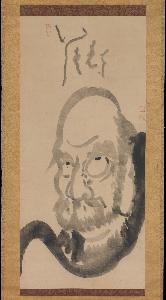Hakuin Ekaku
Hakuin Ekaku
Place: Hara
Born: 1686
Death: 1769
Biography:
Early Life and Training
Hakuin Ekaku, a prominent figure in Japanese Zen Buddhism, was born on January 19, 1686, in the small village of Hara at the foot of Mount Fuji. His mother, a devout Nichiren Buddhist, likely influenced his decision to become a Buddhist monk. As a child, Hakuin attended a lecture by a Nichiren monk on the Eight Hot Hells, which deeply impressed him and instilled a fear of hell. This led him to seek a way to escape it, eventually concluding that becoming a monk was necessary.
Artistic Career
At the age of fifteen, Hakuin obtained his parents' consent to join the monastic life and was ordained at the local Zen temple, Shōin-ji. He served as a novice for three or four years, studying Buddhist texts, including the Lotus Sutra. However, he found it disappointing, saying it consisted of nothing more than simple tales about cause and effect. Hakuin's artistic career is marked by his unique approach to Zen training, integrating meditation and koan practice.
Notable Works and Influence
Although there are no notable paintings directly attributed to Hakuin Ekaku on Wikioo.org, his influence on Japanese art is evident. The Ukiyo-e Art Movement, which flourished from the 17th to 19th centuries, was characterized by woodblock prints and paintings depicting various subjects. Notable artists like Ando Hiroshige and Katsushika Hokusai significantly contributed to Ukiyo-e's global recognition.
Legacy and Impact on Western Art
Ukiyo-e had a profound impact on Western art, particularly during the late 19th century Japonisme trend. Impressionists like Edgar Degas, Édouard Manet, and Claude Monet were influenced by Japanese prints. The Sōsaku-hanga Art Movement, which emerged in early 20th-century Japan, emphasized the artist as the sole creator motivated by a desire for self-expression. Key Points:
- Hakuin Ekaku was a prominent figure in Japanese Zen Buddhism.
- He integrated meditation and koan practice into his Zen training.
- The Ukiyo-e Art Movement flourished from the 17th to 19th centuries.
- Notable artists like Ando Hiroshige and Katsushika Hokusai contributed to Ukiyo-e's global recognition.
- The Sōsaku-hanga Art Movement emphasized the artist as the sole creator motivated by a desire for self-expression.
Conclusion
Hakuin Ekaku's legacy extends beyond his own artistic endeavors, influencing the development of Japanese art and Western art. His unique approach to Zen training and integration of meditation and koan practice continue to inspire artists and scholars today. For more information on Japanese art and artists, visit Wikioo.org or explore the National Museum of Korea and Kobe City Museum collections.






